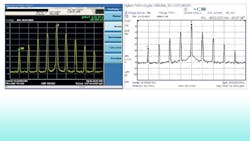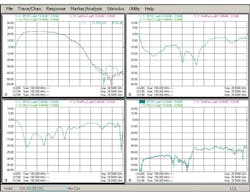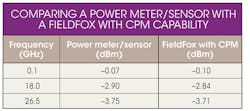Correlate Handheld And Benchtop Measurements
This file type includes high resolution graphics and schematics when applicable.
In order to maintain the performance of wireless communications systems, technicians and engineers are increasingly being asked to head into the field to make RF/microwave measurements—often in less-than-hospitable conditions. While the term “precise microwave measurements” may suggest images of benchtop instrumentation in a laboratory setting, handheld instrumentation has in fact recently become available with the precision necessary to match the performance of these more expensive laboratory counterparts.
Related Articles
• Test Instruments Pack Six Essential Tools
• Affordable Test Equipment Boosts RF/Microwave Development
• Portable Test & Measurement Equipment Provides Benchtop Performance
Modern all-in-one portable instruments now offer technicians and engineers the capabilities to make highly accurate microwave measurements of network, spectrum, power, and frequency with results that correlate to within hundredths of a decibel to benchtop instruments. But not all modern handheld analyzers are created equal. To ensure that a particular handheld instrument of interest can provide the required level of performance, it is necessary to compare or correlate its performance to that of a comparable benchtop instrument.
Examining the specifications found on an instrument vendor’s datasheets is a natural place to start, although it may be difficult to directly compare the two instruments since specifications are often listed under unique operating conditions. A handheld instrument, for example, may be specified for harsh operating conditions, while its benchtop counterpart may be specified for temperature-stabilized environments. Even examining technical literature with cited examples comparing benchtop instruments to handheld instruments is difficult since such material is often very limited.
Bridging this gap requires the actual correlation of measurements recorded using several benchtop instruments to measurements recorded using a handheld instrument. Doing so is the only way to ensure the handheld instrument offers the precision microwave measurements necessary for accurate RF/microwave testing in the field.
Why Correlate?
Correlation describes the relative agreement for a set of data measured from the same device under test (DUT), but recorded from different instruments—for instance, a high-performance benchtop instrument and a handheld instrument. The stronger the agreement, the greater the probability that one measurement technique or instrument can replace another in a given application. In this case, it can be used to determine whether or not a given handheld instrument can effectively provide the same level of measurement accuracy as a benchtop instrument. But why is this correlation so important to ensuring the successful operation of the DUT?
At each stage of a product lifecycle, a DUT (or product) is measured with a variety of different instruments, typically calling for characterization of a unique set of performance requirements. During the early product stages, for example—which include design validation, product development, and manufacturing test—measurements are usually obtained with benchtop instrumentation in controlled laboratory environments. For research and development (R&D) testing, the benchtop instrumentation is selected based on its performance and features.
For production test, important parameters include fast measurement speed and lower instrument cost. Once a new electronic component or system is installed in the field, many of the laboratory measurements must be repeated in the field to validate the performance of the product. Additional field testing may also be required during periodic maintenance and occasional repair operations. Often these field tests are made with a handheld instrument under the most challenging test conditions, including harsh outdoor weather.
In all field testing, correlating the data to laboratory measurements is critical to the successful operation of a device and/or system under test. If the field test data doesn’t correlate well to the laboratory data, components might possibly be failed that are actually good. Likewise, bad components might actually pass tests because of lack of correlation. Strong correlation also ensures agreement by all parties involved that the DUT is actually performing to design standards.
To determine how well measurement data from a given handheld test instrument correlates with data measured using high-performance benchtop instruments, it may be necessary to examine a number of different measurement types (e.g., spectrum analysis, network analysis, and RF power measurements), especially when the handheld instrument can be configured as different instruments [e.g., as a spectrum analyzer, vector network analyzer (VNA), or power meter].
As an example, Fig. 1 shows two spectrum measurements of a 10-GHz multitone signal. The signal has side tones that are equally spaced in frequency, with amplitudes that are 10-dB lower relative to the adjacent tone. The spectrum measurement on the left was captured using a high-performance benchtop signal analyzer, while the measurement on the right was captured using a handheld instrument operating in spectrum-analyzer mode.
To compare the two measurements, delta markers are employed. Note that on the benchtop instrument, the delta marker measures the fourth tone from the center at -40.37 dB, whereas on the handheld instrument, it reads -40.07 dB. This is a resulting difference between the two instruments of only 0.3 dB, which indicates good correlation. The marker results for the other tones also show an excellent correlation between the two instruments. Consequently, although the handheld instrument in this example is not a direct replacement for the benchtop analyzer based on sweep speed and dynamic range, it is well suited both for field testing and general-purpose laboratory testing.
This file type includes high resolution graphics and schematics when applicable.
S-Parameter Comparison
This file type includes high resolution graphics and schematics when applicable.
To compare the results of an S-parameter measurement, consider the example shown in Fig. 2, which uses a 3-to-12-GHz broadband amplifier with a gain of 23 dB as the DUT. In this example, four S-parameters are measured from three different VNAs, two benchtop instruments, and one handheld instrument. All three instruments were configured with a frequency range of 100 MHz to 26.5 GHz, as well as for recording 401 measurement points and operating with an intermediate frequency (IF) bandwidth of 10 kHz. They were calibrated using a full two-port mechanical calibration.
For comparison purposes, the three sets of recorded S-parameters were ported into one of the benchtop instruments and overlaid. As can be seen from Fig. 2, the three sets of measurements are virtually identical except for a deviation in the S21 data from the benchtop instrument, which is signified by the blue trace and only at the high end of the frequency range. There is excellent correlation between the handheld (magenta trace) and the other high-performance benchtop instrument (green trace). Here again, the handheld analyzer shows itself to be ideally suited for S-parameter measurements in the field, as well as for common laboratory applications.
When measuring RF power for continuous wave (CW), pulsed, and complex waveforms, a variety of equipment configurations can be used, with the primary component being a power sensor. The power sensor can be configured with a separate power meter, or else connected to a personal computer (PC) or handheld/benchtop instrument through a Universal-Serial-Bus (USB) cable. The PC or handheld/benchtop instrument is then used simply to display the power measurements. Assuming the same power sensor was used for the handheld and benchtop measurement configurations, both should yield extremely close results.
While the power meter is considered the gold standard for RF power measurement, it is possible to conduct power measurements using a handheld instrument only—assuming, of course, that the handheld instrument has the capability to directly measure signal power. For comparison purposes, the table shows the measured power of a CW test signal as a function of frequency. It compares the measured power using a power sensor and meter combination to that of a measurement taken using a handheld instrument with built-in power measurement capability. While using a handheld instrument may not be as accurate as employing a power sensor, the convenience of using a single instrument to measure power in challenging environments and test conditions cannot be overstated.
As the table details, accurate power measurements are possible with a FieldFox handheld analyzer from Agilent Technologies and its Channel Power Meter (CPM) capability. The measurements with the portable instrument are very close to those made with a dedicated power meter and power sensor combination, and can be made across similar frequency ranges as needed. In making use of the CPM capability, all that is required is a short coaxial cable to connect the portable instrument to the test point and for the user to specify a bandwidth to measure the channel power.
The previous examples effectively demonstrate how to correlate measurement data and clearly show that a modern handheld analyzer is more than capable of performing measurements that have excellent correlation to those recorded from benchtop instruments. One reason this is possible is that modern handhelds utilize some of the same measurement science as their benchtop counterparts. Some high-performance RF and microwave benchtop instruments, for example, rely on custom monolithic microwave integrated circuits (MMICs). Those same MMIC chip designs may also be employed in handheld electronic units to integrate multiple functions into compact, high-performance chipsets.
These highly integrated circuits improve a handheld instrument’s performance and reliability, while also reducing its total power consumption. Additionally, they enable the handheld electronic unit to be configured as different instruments, such as a spectrum analyzer, VNA, power meter, or cable and antenna analyzer, to name a few.
Related Articles
• Test Instruments Pack Six Essential Tools
• Affordable Test Equipment Boosts RF/Microwave Development
• Portable Test & Measurement Equipment Provides Benchtop Performance
In addition to these technological advances, modern handheld instruments now offer features like automatic alignment and built-in calibration, which enable them to maintain a high level of measurement accuracy across their full frequency range. Such capabilities are a key reason why modern handheld instruments now boast high-performance measurement capabilities consistent with those of benchtop instruments.
When using a handheld instrument for field testing, it is essential to ensure its measurement results closely agree with those recorded using benchtop instruments. Correlating the measurement results is one way technicians and engineers can be assured of their agreement. From the correlation examples provided here, it is clear that modern handheld instruments are well equipped for measurements both in the field and within common laboratory applications. For those seeking further details on correlating measurements between portable/handheld instruments and benchtop instruments, a copy of the application note, “Correlating Microwave Measurements Between Handheld and Benchtop Analyzers,” is available for free download.
Tom Hoppin, Application Consultant
Agilent Technologies, 1400 Fountaingrove Pkwy., Santa Rosa, CA 95403; (707) 528-2672
This file type includes high resolution graphics and schematics when applicable.




